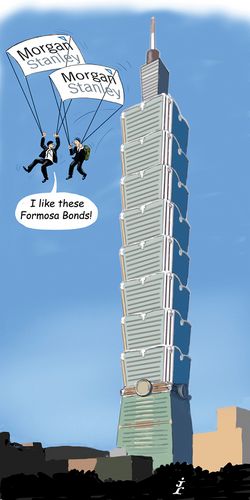Morgan Stanley issued deals in five currencies, paved the way for other banks and corporates to tap the Taiwanese Formosa market, and enjoyed so much outperformance in spreads that it now trades through Goldman Sachs. For these efforts and for the glowing reports from investors about its deal execution, it is IFR’s Financial Issuer of the Year.
There has been a sea change in the way both equity and bond investors have viewed Morgan Stanley in the past year.
Its share price and its spread tightening outperformed peers in 2014 as investors in both markets raced to get a stake in the investment bank. But tighter spreads also require good behaviour in the bond market, something Morgan Stanley seems to understand well.
“Sometimes financial issuers get greedy and instead of looking at investors as partners in their sourcing of capital they execute deals as if it’s the only one they’ll be doing that year,” said a financial institutions group analyst at a global asset management firm.
“Morgan Stanley isn’t like that. It’s a responsible issuer.”
Morgan Stanley could have exploited its improving credit story to squeeze out bigger deals at tighter spreads, but instead it hooked in the extra investor attention both at home and abroad by pricing and sizing deals for performance.
“We take a long-term perspective,” said Ruth Porat, Morgan Stanley’s CFO. “We issue regularly and want to make sure we have a committed, deep investor pool. Our debt investors, like our equity investors, are valued stakeholders.”
This policy was seen at work in January when the US investor base was buckling under the weight of US$50bn of new FIG issuance in the first weeks of the year, including a US$5.25bn five-part offering of senior unsecured debt from JP Morgan and US$2.75bn of five-year fixed and floating-rate notes by Morgan Stanley.
The JP Morgan deal, which was priced on the screws, failed to perform and widened in ensuing days to the point where it weighed on sentiment generally in the new issue market.
Morgan Stanley, however, sensed the possibility of pushback and left about 6bp of new issue concession to ensure aftermarket performance. Its new notes tightened as a result and investors made note of the stark difference between the two issuers.
Throughout the year Morgan Stanley’s spreads outperformed steadily, to the point where they are trading tighter than Goldman Sachs for the first time in years.
That achievement gave it an extra pricing boost in non-core markets, where it sold bonds in euros, yen, Canadian dollars and Australian dollars.
“Both Canadian and Australian dollar investors are pro-active in saying ‘this is where Goldman trades, so we expect you will be looking to price tighter than that’,” said Paul Spivack, head of debt syndicate at Morgan Stanley in New York.
Diversification was a major theme for Morgan Stanley. In the mid-November 2013 to mid-November 2014 awards period Morgan Stanley issued about US$28.6bn of benchmark deals, according to Thomson Reuters data, across five currencies – US dollars, yen, Canadian dollars, Aussie dollars and euros – its greatest amount of diversification in several years.
Highlights included two euro deals totalling €2.75bn, with the €1.5bn 2.375% 2021s issued in March its largest euro deal since 2011.
In May, Morgan Stanley issued a three-tranche ¥150bn deal, the largest Samurai bond offering in nearly two years and Morgan Stanley’s first Samurai since 2008.
In July, the bank went to Canada to issue C$750m of 3.125% 2021s, the largest financial Maple bond in two years.
In August, Morgan Stanley became the first US bank to issue in the Formosa market, after its capital markets team pointed out regulatory changes that allowed foreign borrowers to tap into Taiwanese pension funds in need of a source of US dollar assets.
“We work very closely with our capital markets colleagues, who … enable us to have a good lens on opportunities around the globe,” said Porat.
The deal was priced inside its US dollar paper, and was quickly followed by other Western banks.
By pioneering a new US dollar market, Morgan Stanley’s treasury department paved the way for its DCM team to be the first to underwrite US corporate Formosa issues, with deals from Verizon and AT&T.
To see the digital version of the IFR Review of the Year, please click here.
To purchase printed copies or a PDF of this report, please email gloria.balbastro@thomsonreuters.com.




